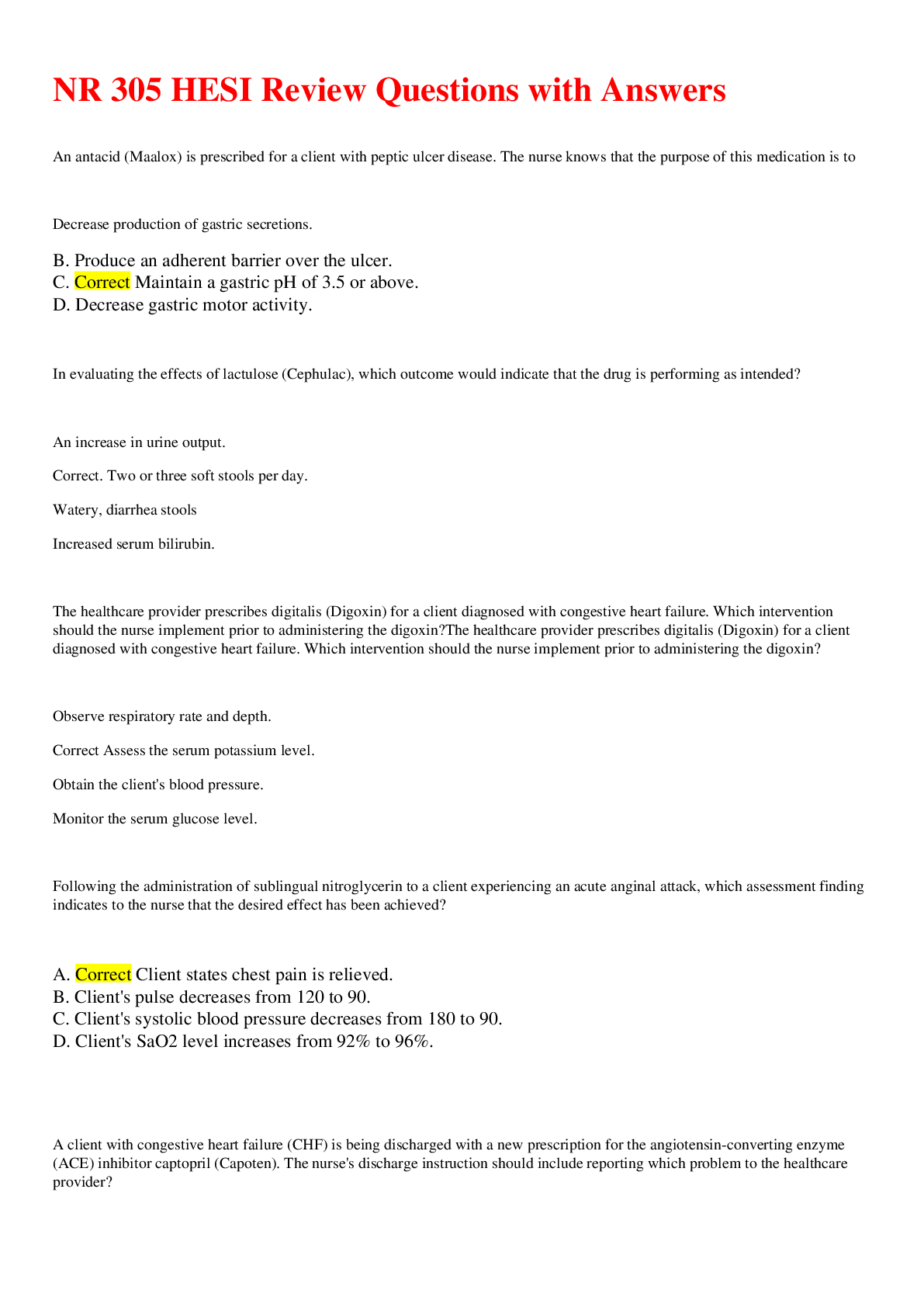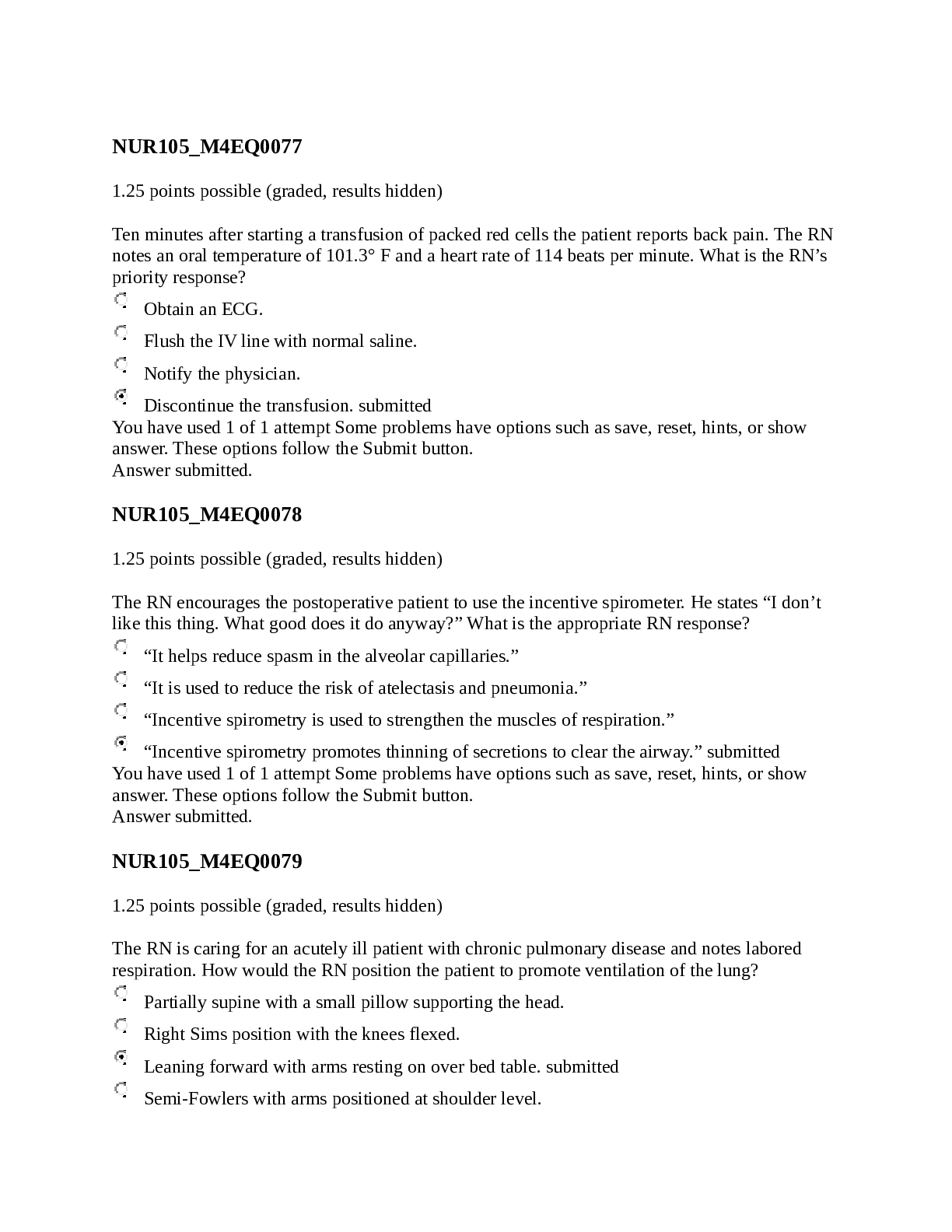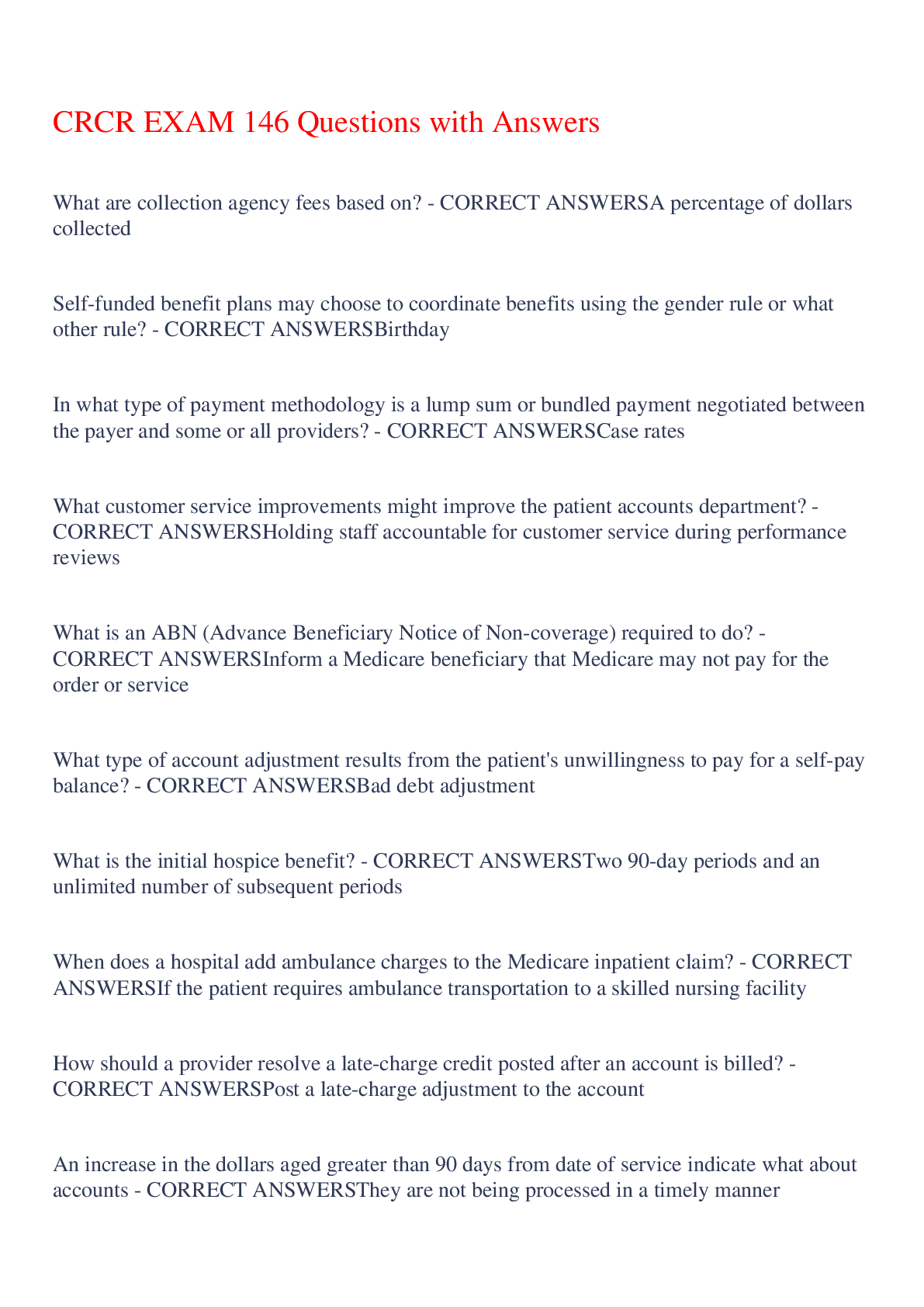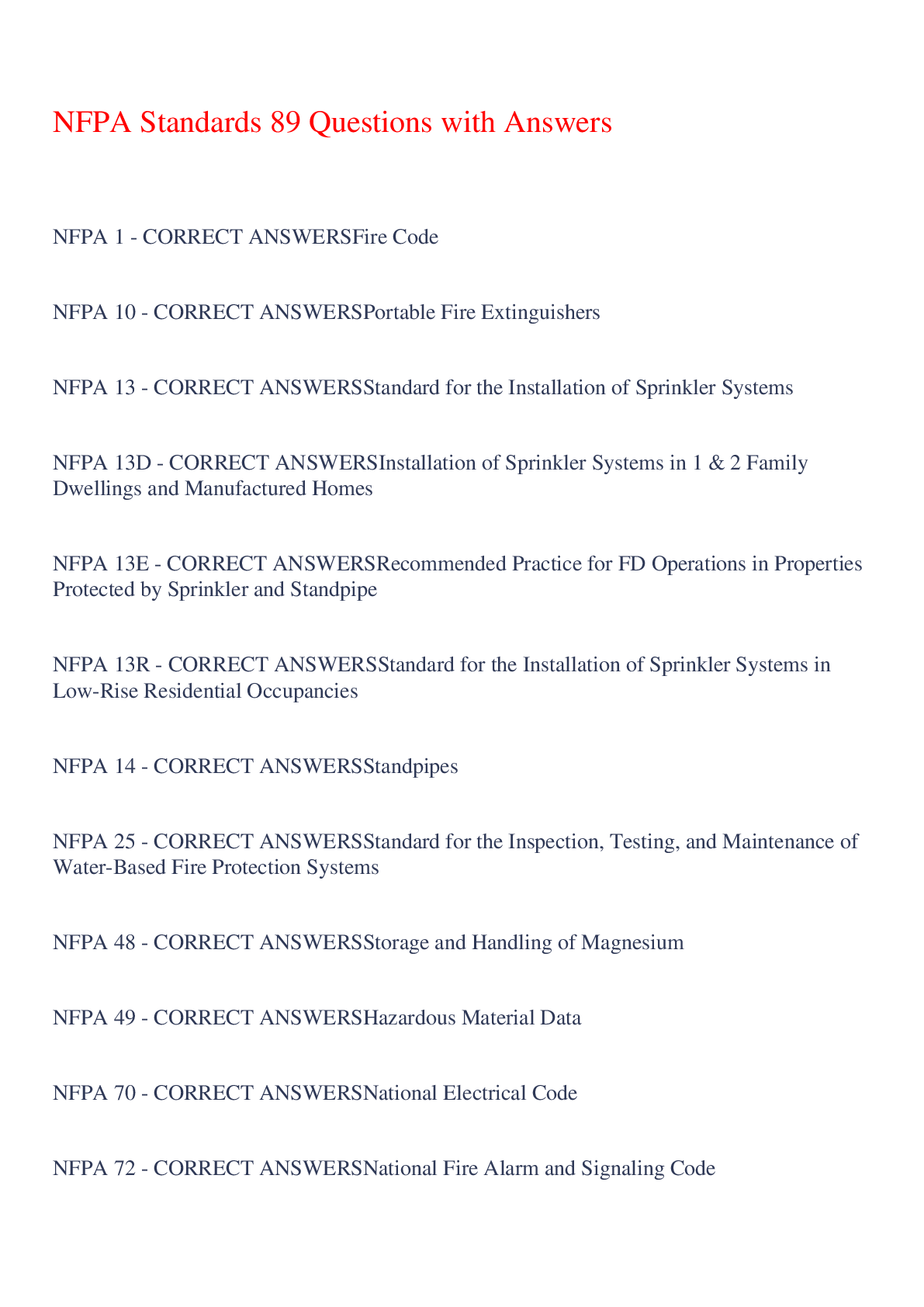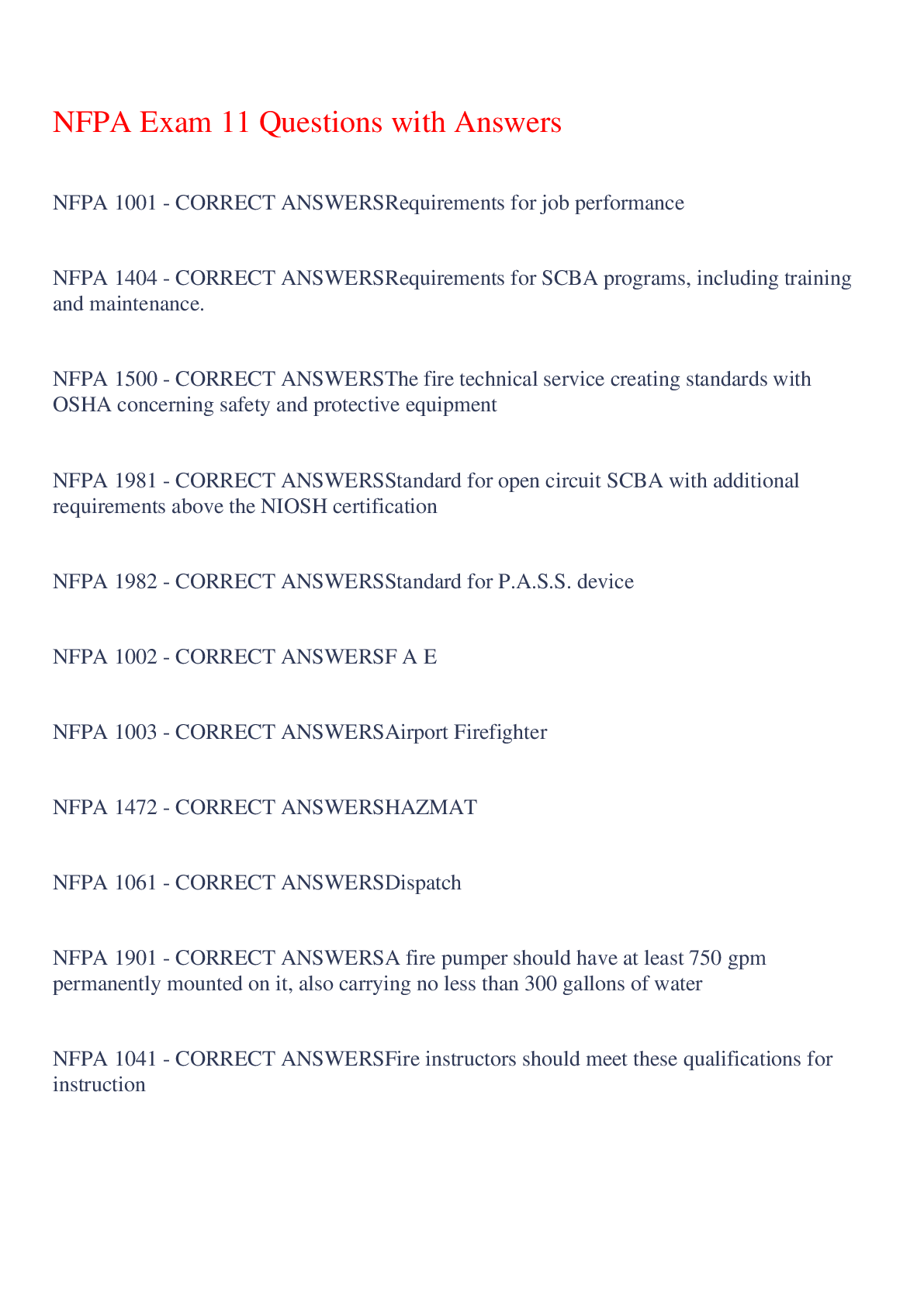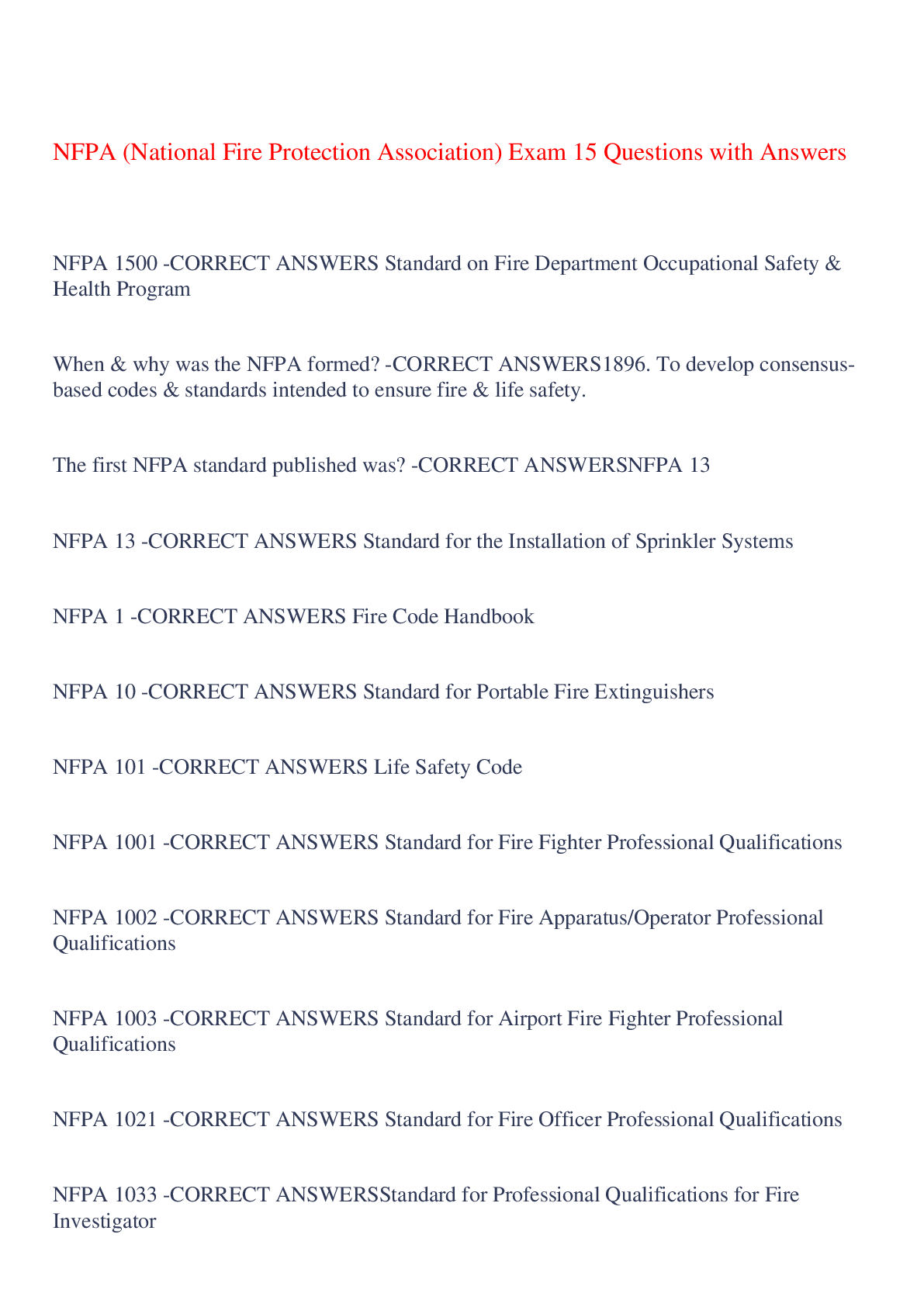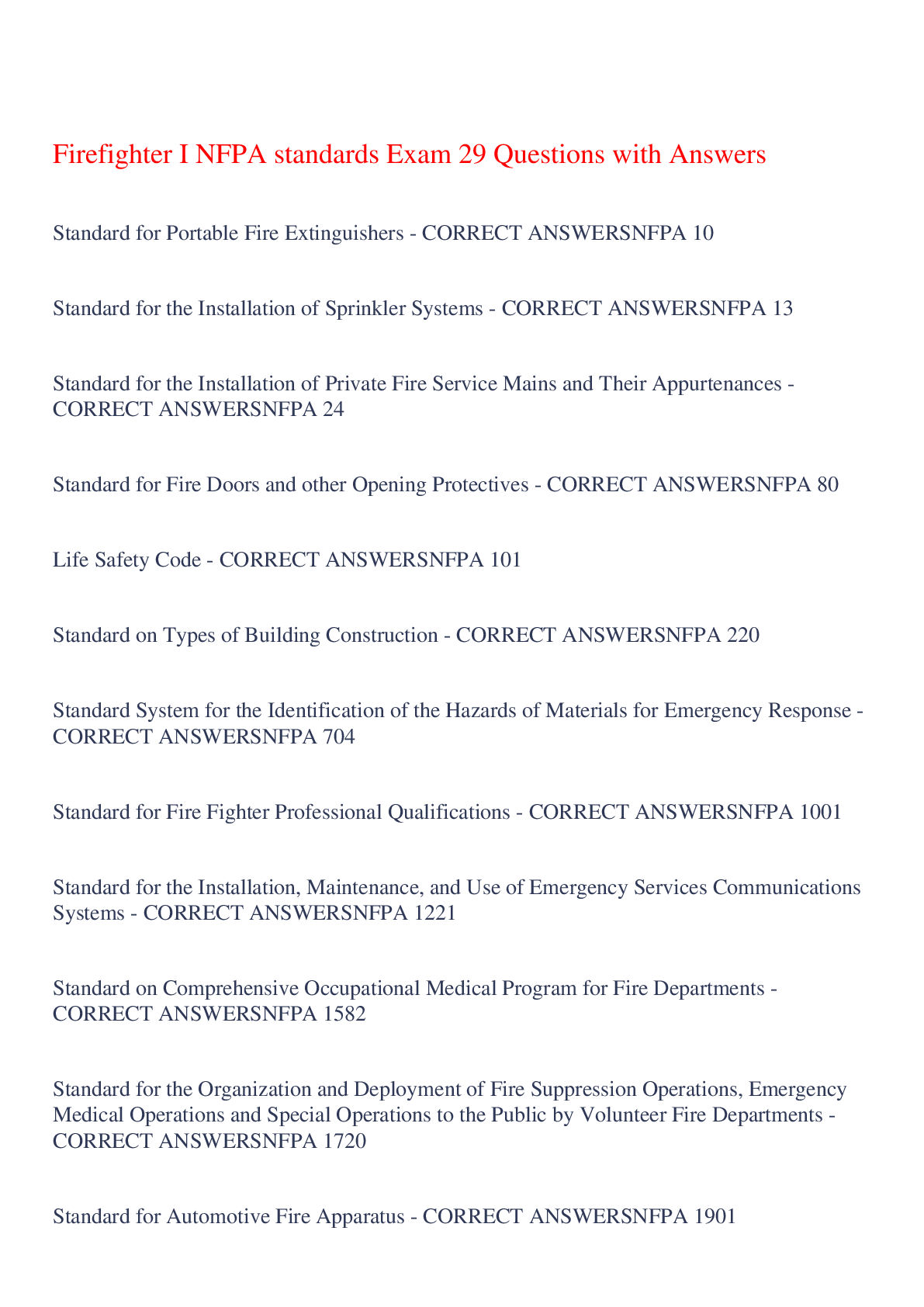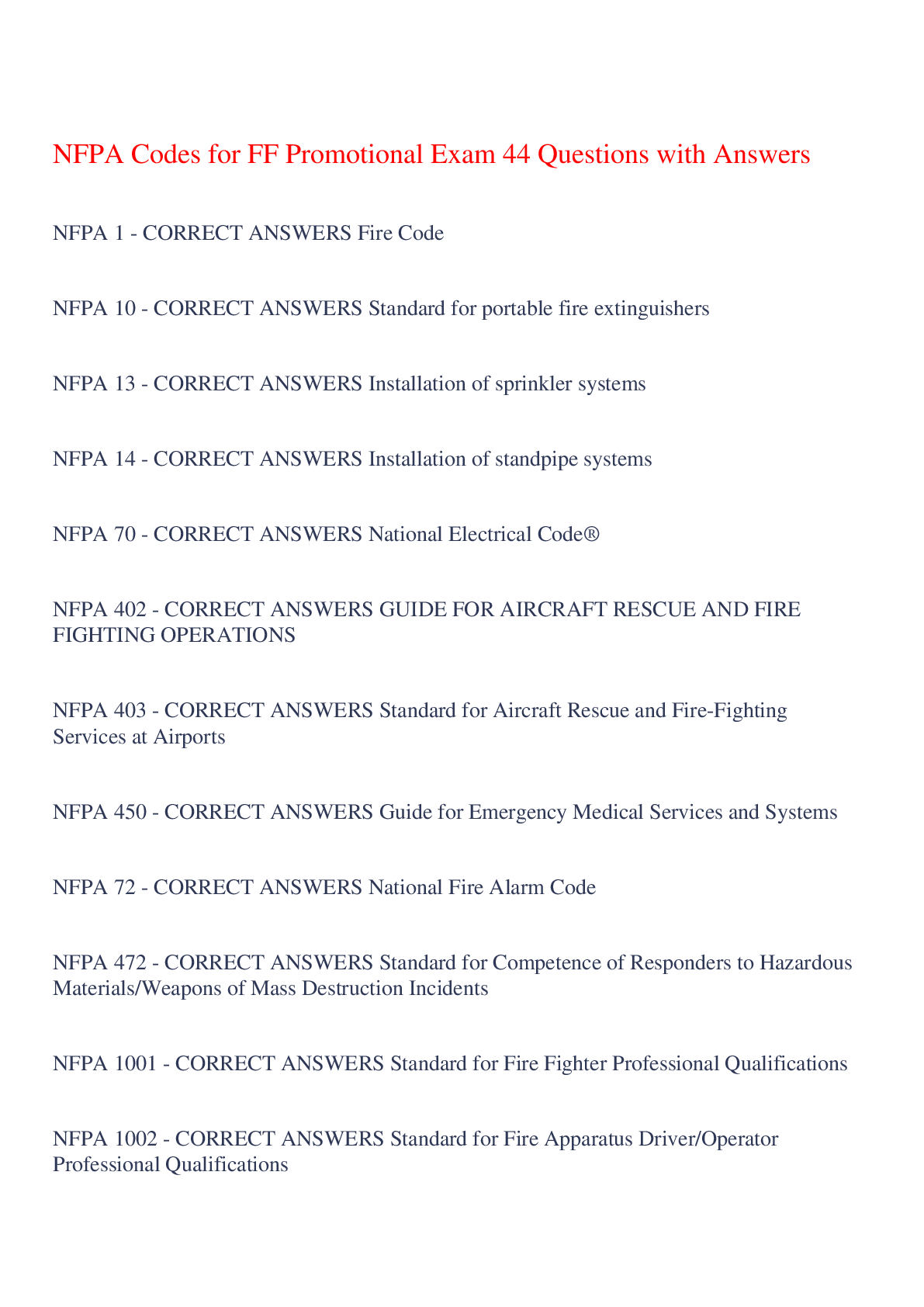NR 222 Exam #1 Chamberlain|157 Questions with Answers,100% CORRECT
Document Content and Description Below
NR 222 Exam #1 Chamberlain|157 Questions with Answers CHAPTER 1 - Nursing Today Benner's Model of Novice to Expert - CORRECT ANSWER Novice Advanced beginner Competent Proficient Expert ... ANA definition of nursing - CORRECT ANSWER the protection, promotion, and optimization of health and abilities, prevention of illness and injury, alleviation of suffering through the diagnosis and treatment of human response, and advocacy in the care of individuals, families, communities, and populations ANA Standards of Nursing Practice - CORRECT ANSWER Assessment Diagnosis Outcomes Identification Planning Implementation Coordination of Care Health Teaching + Health Promotion Consultation Prescriptive Authority + Treatment Evaluation ANA Standards of Professional Performance - CORRECT ANSWER Ethics Education Evidence-Based Practice Quality of Practice Communication Leadership Collaboration Professional Practice Resources Environmental Health Autonomy - CORRECT ANSWER Essential element of professional nursing that involves the initiation of independent nursing interventions without medical orders. Advanced Practice Registered Nurse (APRN) - CORRECT ANSWER Most independently functioning nurse; has masters degree in nursing Clinical Nurse Specialist (CNS) - CORRECT ANSWER An APRN who is an expert clinician in a specialized area of practice Nurse Practioner (NP) - CORRECT ANSWER Are prepared to provide direct client care in primary care settings, focusing on health promotion, illness prevention, early diagnosis, and treatment of common health problems Certified Nurse-Midwife (CNM) - CORRECT ANSWER An APRN who is also educated in midwifery and is certified by the American College of Nurse-Midwifes Certified Registered Nurse Anesthetist (CRNA) - CORRECT ANSWER An APRN with advanced education in a nurse anesthetia accredited program Nurse Educator - CORRECT ANSWER works primarily in schools of nursing, staff development departments of health care agencies, and patient education departments Nurse Administrator - CORRECT ANSWER manages patient care and the delivery of specific nursing services within a health care agency Nurse Researcher - CORRECT ANSWER conducts evidence-based practice and research to improve nursing care and further define and expand the scope of nursing practice Florence Nightingale - CORRECT ANSWER Founder of modern nursing; started first organized program to train nurses; first practicing nurse epidemiologist; connected sanitation with cholera and dysentery Clara Barton - CORRECT ANSWER Nurse during the Civil War; founder of the American Red Cross Mary Mahoney - CORRECT ANSWER First professionally trained African American nurse Mary Adelaide Nutting - CORRECT ANSWER First professor of nursing at Columbia University Teachers College in 1906. Compassion fatigue - CORRECT ANSWER described as physical, emotional, and spiritual exhaustion resulting from seeing patients suffer, leads to a decreased capacity to show compassion or empathize with suffering people Burnout - CORRECT ANSWER Occurs when perceived demands outweigh perceived resources Lateral violence - CORRECT ANSWER Aggressive and destructive behavior or psychological harassment of nurses against each other Genomics - CORRECT ANSWER Study of whole genomes, including genes and their functions CHAPTER 2 - CORRECT ANSWER Health Care Delivery System Health Services Pyramid - CORRECT ANSWER Managing health instead of illness Emphasis on wellness Injury prevention programs Primary Health Care - CORRECT ANSWER Focuses on improved health outcomes for an entire population; includes primary care and health education, proper nutrition, maternal/child health care, family planning, vaccines, and control of diseases Intensive Care - CORRECT ANSWER Patients receive close monitoring and intensive medical care Psychiatric Facilities - CORRECT ANSWER Patients who suffer emotional and behavioral problems such as depression, violent behavior, and eating disorders often require special counseling and treatment in psychiatric facilities Rural Hospitals - CORRECT ANSWER Located in a county that has a low population density Restorative Care - CORRECT ANSWER Care that helps persons regain their health, strength, and independence Home Care - CORRECT ANSWER Provision of medically related professional and paraprofessional services and equipment to patients and families in their homes for health maintenance, education, illness prevention, diagnosis and treatment of disease, palliation, and rehabilitation Rehabilitation - CORRECT ANSWER Restores a person to the fullest physical, mental, social, vocational, and economic potential possible Extended Care Facility - CORRECT ANSWER A facility that provides health care and help with the activities of daily living to people who may be physically or mentally unable to care for themselves; this type of care may last from days to years Skilled Nursing Facility (SNF) - CORRECT ANSWER Includes administration of IV fluids, wound care, long term ventilator management, and rehab Continuing Care - CORRECT ANSWER For people who are disabled, functionally dependent, or suffering a terminal disease Assisted Living - CORRECT ANSWER A living arrangement for elderly people that combines privacy and independence with medical supervision Respite Care - CORRECT ANSWER A type of care provided for caregivers of homebound ill, disabled, or elderly patients; gives the normal care-takers time off Adult Day Care - CORRECT ANSWER A program for impaired adults that attempts to meet their health, social, and functional needs in a setting away from their homes Hospice - CORRECT ANSWER Allows patient to live with comfort, independence, and dignity while easing the pains of terminal illness IOM Competencies - CORRECT ANSWER Patient Centered Care Work in Interdisciplinary Teams Use Evidence-Based Practice Apply Quality Improvement Use Informatics Ten Rules of Performance in a Redesigned Health Care System - CORRECT ANSWER 1. Care is based on continuous healing relationships 2. Care is individualized based on patient needs and values 3. Patient is the source of control, participates in decision-making 4. Knowledge is shared, info flows freely 5. Decision making is evidence-based 6. Safety is a system property and focused on reducing errors 7. Transparency is necessary through sharing info with patients and families 8. Patients needs are anticipated 9. Waste is continuously decreased 10. Cooperation and communication among clinicians are priorities Quality Health Care - CORRECT ANSWER The degree to which health services for individuals and populations increase the likelihood of desired health outcomes and are consistent with current professional knowledge Pay for performance programs - CORRECT ANSWER Designed to promote quality, effective, and safe patient care by physicians and health care organizations Quality improvement strategies that reward excellence through financial incentives to motivate change to achieve measurable improvements Six Sigma - CORRECT ANSWER A data-driven approach for improving quality by removing defects and variations in processes Patient-Centered Care - CORRECT ANSWER Recognize the patient or designee as the source of control and full partner in providing compassionate and coordinated care based on respect for patient's preferences, values, and needs Magnet Recognition Program - CORRECT ANSWER Recognition by the American Nurses Credentialing Center that an organization provides quality nursing care Nursing-sensitive outcomes - CORRECT ANSWER Patient outcomes and nursing workforce characteristics that are directly related to nursing care such as changes in patients' symptom experiences, functional status, safety, psychological distress, registered nurse job satisfaction, total nursing hours per patient day, and costs Nursing Quality Indicators - CORRECT ANSWER Outcomes of nursing care, identified by the American Nurses Association, that address patient safety and quality of care Nursing informatics - CORRECT ANSWER Uses information and technology to communicate, manage knowledge, mitigate error, and support decision making Telemedicine - CORRECT ANSWER Involves the use of video, audio, and computer systems to provide medical and/or health care services Vulnerable populations - CORRECT ANSWER Collection of individuals who are more likely to develop health problems as a result of excess risks, limits in access to health care services, or being dependent on others for care CHAPTER 6 - CORRECT ANSWER Health and Wellness Healthy People 2020 - CORRECT ANSWER A set of disease prevention and health promotion objectives for Americans to meet during the second decade of the new millennium Health - CORRECT ANSWER A state of complete physical, mental, and social well-being, not merely the absence of disease or infirmity. Health beliefs - CORRECT ANSWER A person's ideas, convictions, and attitudes about health and illness Positive health behaviors - CORRECT ANSWER Activities related to maintaining, attaining, or regaining good health and preventing illness Negative health behaviors - CORRECT ANSWER Inculde practices actually or potentially harmful to health such as smoking, drug or alcohol abuse, poor diet and refusal to take necessary medications Health Belief Model - CORRECT ANSWER Addresses the relationship between a person's beliefs and behaviors Health Promotion Model - CORRECT ANSWER Directed at increasing a patient's level of well-being Maslow's Hierarchy of Needs - CORRECT ANSWER Physiological Safety Love + Belonging Self Esteem Self-actualization Holistic Health Model - CORRECT ANSWER Attempts to create conditions that promote optimal health Internal Variables that Influence Health - CORRECT ANSWER Developmental stage, intellectual background, perception of functioning, emotional factors, spiritual factors External Variables that Influence Health - CORRECT ANSWER Family practices, socioeconomic factors, cultural background Health promotion - CORRECT ANSWER The process of enabling people to increase control over, and to improve, their health Illness Prevention - CORRECT ANSWER Health education programs or activities directed toward protecting patients from threats or potential threats to health and minimizing risk factors Passive Health Promotion Strategies - CORRECT ANSWER Ex. Fluoride in water, fortified foods Active Health Promotion Strategies - CORRECT ANSWER Ex. weight reduction, smoking-cessation Levels of Preventive Care - CORRECT ANSWER Primary, secondary, tertiary Primary Prevention - CORRECT ANSWER True prevention, precedes disease or disfunction and applied to patients considered physically and emotionally healthy Includes: health education, vaccines, nutritional programs, fitness activities Secondary Prevention - CORRECT ANSWER Focuses on individuals who are experiencing health problems or illnesses and are at risk for developing complications or worsening conditions Tertiary Prevention - CORRECT ANSWER Occurs when a defect or disability is permanent or irreversible; involves minimizing the effects of long-term disease or disability by interventions directed at preventing complications and deterioration Risk Factor - CORRECT ANSWER Any situation, habit, or other variable such as social, environmental, physiological, psychological, developmental, intellectual, or spiritual that increases the vulnerability of an individual or group to an illness or accident Transtheoretical Model of Change - CORRECT ANSWER 1. Precontemplation 2. Contemplation 3. Preparation 4. Action 5. Maintenance Illness - CORRECT ANSWER A state in which a person's physical, emotional, intellectual, social, developmental, or spiritual functioning is diminished or impaired Acute Illness - CORRECT ANSWER A sudden illness from which a person is expected to recover Chronic Illness - CORRECT ANSWER Persists longer than 6 months, is irreversible, and affects functioning in one or more systems Illness Behavior - CORRECT ANSWER Ways in which people monitor their bodies, define and interpret their symptoms, take remedial actions, and use the health care system. CHAPTER 16 - CORRECT ANSWER Nursing Assessment Nursing Process - CORRECT ANSWER Assessment Diagnosis Planning Implementation Evaluation Nursing Assessment - CORRECT ANSWER Systematic and continuous collection and analysis of information about the client Two Steps: 1. Collect info from primary source (pt) and secondary sources (family, friends, health prof, records) 2. Interpret and validate data to ensure complete database Critical thinking and the assessment process - CORRECT ANSWER Cue - CORRECT ANSWER Information that you obtain through use of the senses Inference - CORRECT ANSWER Your judgement or interpretation of these cues Health perception-health management pattern - CORRECT ANSWER Describes patient's self-report of health and well-being; how patient manages health (e.g., frequency of health care provider visits, adherence to therapies at home); knowledge of preventive health practices Nutritional-Metabolic Pattern - CORRECT ANSWER Describes patient's daily/weekly pattern of food and fluid intake (e.g., food preferences or restrictions, special diet, appetite); actual weight; weight loss or gain. Elimination Pattern - CORRECT ANSWER Describes patterns of excretory function (bowel, bladder, and skin) Activity-Exercise Pattern - CORRECT ANSWER Describes patterns of exercise, activity, leisure, and recreation; ability to perform activities of daily living Sleep-Rest Pattern - CORRECT ANSWER Describes patterns of sleep, rest, and relaxation. Cognitive-Perceptual Pattern - CORRECT ANSWER Describes sensory-perceptual patterns; language adequacy, memory, decision-making ability Self-Perception-Self-Concept Pattern - CORRECT ANSWER Describes patient's self-concept pattern and perceptions of self (e.g., self-concept/worth, emotional patterns, body image) Role-Relationship Pattern - CORRECT ANSWER Describes patient's patterns of role engagements and relationships Sexuality-Reproductive Pattern - CORRECT ANSWER Describes patient's patterns of satisfaction and dissatisfaction with sexuality pattern; patient's reproductive patterns; premenopausal and postmenopausal problems Coping-Stress Tolerance Pattern - CORRECT ANSWER Describes patient's ability to manage stress; sources of support; effectiveness of the patterns in terms of stress tolerance Value-Belief Pattern - CORRECT ANSWER Describes patterns of values, beliefs including spiritual practices, and goals that guide patient's choices or decisions Problem-Focused Patient Assessment - CORRECT ANSWER Subjective Data - CORRECT ANSWER Things a person tells you about that you cannot observe through your senses; symptoms Includes patient's feelings, perceptions, and self-reported symptoms Patient-Centered Interview - CORRECT ANSWER Requires: courtesy, comfort, connection, confirmation PQRST - CORRECT ANSWER Provokes Quality Radiate Severity Time Interview Techniques - CORRECT ANSWER Observation Open-ended questions Leading question Back channeling Probing Direct close-ended questions Concomitant Symptoms - CORRECT ANSWER Does the patient experience other symptoms along with the primary symptom? For example, does nausea accompany pain? Review of Systems (ROS) - CORRECT ANSWER A systematic approach for collecting the patient's self-reported data on all body systems. Validation of assessment data - CORRECT ANSWER is the comparison of data with another source to determine data accuracy CHAPTER 22 - CORRECT ANSWER Ethics and Values Autonomy - CORRECT ANSWER Refers to the freedom from external control Beneficence - CORRECT ANSWER Refers to taking positive actions to help others Nonmaleficence - CORRECT ANSWER Refers to the avoidance of harm or hurt Fidelity - CORRECT ANSWER Agreement to keep promises Code of ethics - CORRECT ANSWER A set of guiding principles that all members of a profession accept Advocacy - CORRECT ANSWER Refers to the support of a particular cause Value - CORRECT ANSWER A personal belief about the worth of a given idea, attitude, custom, or object that sets standards that influence behavior Deontology - CORRECT ANSWER Proposes a system of ethics that comes from the work of an eighteenth century philosopher, Immanuel Kant Deontology defines actions as right or wrong on the basis of their "right-making characteristics" such as fidelity to promises, truthfulness, and justice Utilitarianism - CORRECT ANSWER Relies on the application of a certain principle; focuses on outcomes Proposes the value of something is determined by it's usefulness Also known as consequentialism Feminist ethics - CORRECT ANSWER Looks to the nature of relationships to guide participants in making difficult decisions, especially relationships in which power is unequal or in which a POV has become ignored or invisible Ethics of care - CORRECT ANSWER Strives to address issues beyond individual relationships by raising ethical concerns about the structures within which individual caring occurs (structures such as hospitals or universities) Casuistry - CORRECT ANSWER Case-based reasoning, turns away from conventional principles of ethics as a way to determine best actions and focuses instead on an "intimate understanding of particular situations" Key Steps in the Resolution of an Ethical Dilemma - CORRECT ANSWER 1) Ask the ? is this an ethical dilemma 2) Gather info relevant to the case 3) Clarify values; distinguish among fact, opinion, & values. 4) Verbalize the problem 5) Identify possible courses of action 6) Negotiate a plan 7) Evaluate the plan overtime CHAPTER 9 - CORRECT ANSWER Cultural Awareness Health disparity - CORRECT ANSWER A particular type of health difference that is closely linked with social, economic, and/or environmental disadvantage Social determinants of health - CORRECT ANSWER The conditions in which people are born, grow, live, work, and age, shaped by the distribution of money, power, and resources at global, national, and local levels Culture - CORRECT ANSWER Associated with norms, values, and traditions passed through generations It also has been perceived to be the same as ethnicity, race, nationality, and language Intersectionality - CORRECT ANSWER Overlapping of social categories such as race, class, gender as they apply to a given individual or group. Creates interdependent systems of discrimination/ disadvantage Oppression - CORRECT ANSWER A formal and informal system of advantages and disadvantages tied to our membership in social groups, such as those at work, at school, and in families Culturally congruent care - CORRECT ANSWER Care that fits a person's life patterns, values, and system of meaning Meaning of Disease and Illness - CORRECT ANSWER Culture affects how an individual defines the meaning of illness Cultural Competency - CORRECT ANSWER The enabling of health care providers to deliver services that are respectful of and responsive to the health beliefs, practices, and cultural and linguistic needs of diverse patients Culturally competent organizations - CORRECT ANSWER - Value diversity - Conduct a cultural self assessment -Manage the dynamics of difference - Institutionalize cultural knowledge - Adapt to diversity World view - CORRECT ANSWER Determines how people perceive others, how they interact and relate to reality, and how they process information Emic - CORRECT ANSWER approach of studying a culture's behavior from the perspective of an INSIDER Etic - CORRECT ANSWER approach of studying a culture's behavior from the perspective of an OUTSIDER Goal of cultural assessment - CORRECT ANSWER To obtain accurate information from a patient that allows you to formulate a mutually acceptable and culturally relevant plan of care for each health problem of a patient Explanatory model - CORRECT ANSWER a patient's views about health and illness and its treatment LEARN - CORRECT ANSWER Listen Explain Acknowledge Recommend Negotiate RESPECT - CORRECT ANSWER Rapport Empathy Support Partnership Cultural competence Trust ETHNIC - CORRECT ANSWER Explanation Treatment Healers Negotiate Intervention Collaboration C-LARA - CORRECT ANSWER Calm Listen Affirm Respond Add Linguistic competence - CORRECT ANSWER The ability of an organization and its staff to communicate effectively and convey information in a manner that is easily understood by diverse audiences Teach Back technique - CORRECT ANSWER Have patient repeat directions observe that message is understood restate directions speak louder speak slower use a translator Cultural encounter - CORRECT ANSWER An intervention that involves a nurse directly interacting with patients from culturally diverse backgrounds Cultural desire - CORRECT ANSWER The motivation of a health care professional to "want to" not "have to" engage in the process of becoming culturally competent Core measures - CORRECT ANSWER Key quality indicators that help health care institutions improve performance, increase accountability, and reduce costs CHAPTER 10 - CORRECT ANSWER Caring for Families Nuclear family - CORRECT ANSWER Mother, father and children living as a unit Extended family - CORRECT ANSWER Includes the nuclear family plus grandparents, aunts, uncles, and cousins Single-parent family - CORRECT ANSWER Formed when one parent leaves the nuclear family because of death, divorce, or desertion or when a single person decides to have or adopt a child Blended family - CORRECT ANSWER Formed when a single parent marries another person, who may or may not have children Alternative family - CORRECT ANSWER Relationships include multi-adult households, "skip-generation" families (grandparents caring for grandchildren), communal groups with children, "nonfamilies" (adults living alone), and cohabitating partners Five trends as threats or concerns facing families - CORRECT ANSWER 1) Changing economic status 2) Homelessness 3) Domestic violence 4) Presence of acute or chronic illnesses or trauma 5) End of life care Absolute Homelessness vs. Relative Homelessness - CORRECT ANSWER Absolute - people without physical shelter who sleep outdoors, in vehicles, in abandoned buildings, or in other places not intended for human habitation Relative - describes those who have a physical shelter but one that does not meet the standards of health and safety Stages of Family Life Cycle - CORRECT ANSWER Family Health System (FHS) - CORRECT ANSWER Interactive Developmental Coping Integrity Health Family hardiness - CORRECT ANSWER Internal strengths and durability of the family unit; characterized by a sense of control over the outcome of life events and hardships, a view of change as beneficial and growth-producing, and an active rather than passive orientation in responding to stressful life events Family resiliency - CORRECT ANSWER Helps to evaluate healthy responses when individuals and families experience stressful events Family nursing practice has three levels of approaches - CORRECT ANSWER 1) Family as context 2) Family as patient 3) Family as system Family as context - CORRECT ANSWER Primary focus is on the health and development of an individual member existing within a specific environment Family as patient - CORRECT ANSWER Family processes and relationships are the primary focuses of nursing care Family as system - CORRECT ANSWER A family can be seen as a relatively organized collection of interdependent parts that act together as a whole unit Nursing process for the family - CORRECT ANSWER 1) Assess al individuals within their family context 2) Assess the family as patient 3) Assess the family as a system Family Caregiving - CORRECT ANSWER A family process that occurs in response to an illness and encompasses multiple cognitive, behavioral, and interpersonal processes CHAPTER 1 - CORRECT ANSWER Nursing Today Benner's Model of Novice to Expert - CORRECT ANSWER Novice Advanced beginner Competent Proficient Expert ANA definition of nursing - CORRECT ANSWER the protection, promotion, and optimization of health and abilities, prevention of illness and injury, alleviation of suffering through the diagnosis and treatment of human response, and advocacy in the care of individuals, families, communities, and populations ANA Standards of Nursing Practice - CORRECT ANSWER Assessment Diagnosis Outcomes Identification Planning Implementation Coordination of Care Health Teaching + Health Promotion Consultation Prescriptive Authority + Treatment Evaluation ANA Standards of Professional Performance - CORRECT ANSWER Ethics Education Evidence-Based Practice Quality of Practice Communication Leadership Collaboration Professional Practice Resources Environmental Health Autonomy - CORRECT ANSWER Essential element of professional nursing that involves the initiation of independent nursing interventions without medical orders. Advanced Practice Registered Nurse (APRN) - CORRECT ANSWER Most independently functioning nurse; has masters degree in nursing Clinical Nurse Specialist (CNS) - CORRECT ANSWER An APRN who is an expert clinician in a specialized area of practice Nurse Practioner (NP) - CORRECT ANSWER Are prepared to provide direct client care in primary care settings, focusing on health promotion, illness prevention, early diagnosis, and treatment of common health problems Certified Nurse-Midwife (CNM) - CORRECT ANSWER An APRN who is also educated in midwifery and is certified by the American College of Nurse-Midwifes Certified Registered Nurse Anesthetist (CRNA) - CORRECT ANSWER An APRN with advanced education in a nurse anesthetia accredited program Nurse Educator - CORRECT ANSWER works primarily in schools of nursing, staff development departments of health care agencies, and patient education departments Nurse Administrator - CORRECT ANSWER manages patient care and the delivery of specific nursing services within a health care agency Nurse Researcher - CORRECT ANSWER conducts evidence-based practice and research to improve nursing care and further define and expand the scope of nursing practice Florence Nightingale - CORRECT ANSWER Founder of modern nursing; started first organized program to train nurses; first practicing nurse epidemiologist; connected sanitation with cholera and dysentery Clara Barton - CORRECT ANSWER Nurse during the Civil War; founder of the American Red Cross Mary Mahoney - CORRECT ANSWER First professionally trained African American nurse Mary Adelaide Nutting - CORRECT ANSWER First professor of nursing at Columbia University Teachers College in 1906. Compassion fatigue - CORRECT ANSWER described as physical, emotional, and spiritual exhaustion resulting from seeing patients suffer, leads to a decreased capacity to show compassion or empathize with suffering people Burnout - CORRECT ANSWER Occurs when perceived demands outweigh perceived resources Lateral violence - CORRECT ANSWER Aggressive and destructive behavior or psychological harassment of nurses against each other Genomics - CORRECT ANSWER Study of whole genomes, including genes and their functions CHAPTER 2 - CORRECT ANSWER Health Care Delivery System Health Services Pyramid - CORRECT ANSWER Managing health instead of illness Emphasis on wellness Injury prevention programs Primary Health Care - CORRECT ANSWER Focuses on improved health outcomes for an entire population; includes primary care and health education, proper nutrition, maternal/child health care, family planning, vaccines, and control of diseases Intensive Care - CORRECT ANSWER Patients receive close monitoring and intensive medical care Psychiatric Facilities - CORRECT ANSWER Patients who suffer emotional and behavioral problems such as depression, violent behavior, and eating disorders often require special counseling and treatment in psychiatric facilities Rural Hospitals - CORRECT ANSWER Located in a county that has a low population density Restorative Care - CORRECT ANSWER Care that helps persons regain their health, strength, and independence Home Care - CORRECT ANSWER Provision of medically related professional and paraprofessional services and equipment to patients and families in their homes for health maintenance, education, illness prevention, diagnosis and treatment of disease, palliation, and rehabilitation Rehabilitation - CORRECT ANSWER Restores a person to the fullest physical, mental, social, vocational, and economic potential possible Extended Care Facility - CORRECT ANSWER A facility that provides health care and help with the activities of daily living to people who may be physically or mentally unable to care for themselves; this type of care may last from days to years Skilled Nursing Facility (SNF) - CORRECT ANSWER Includes administration of IV fluids, wound care, long term ventilator management, and rehab Continuing Care - CORRECT ANSWER For people who are disabled, functionally dependent, or suffering a terminal disease Assisted Living - CORRECT ANSWER A living arrangement for elderly people that combines privacy and independence with medical supervision Respite Care - CORRECT ANSWER A type of care provided for caregivers of homebound ill, disabled, or elderly patients; gives the normal care-takers time off Adult Day Care - CORRECT ANSWER A program for impaired adults that attempts to meet their health, social, and functional needs in a setting away from their homes Hospice - CORRECT ANSWER Allows patient to live with comfort, independence, and dignity while easing the pains of terminal illness IOM Competencies - CORRECT ANSWER Patient Centered Care Work in Interdisciplinary Teams Use Evidence-Based Practice Apply Quality Improvement Use Informatics Ten Rules of Performance in a Redesigned Health Care System - CORRECT ANSWER 1. Care is based on continuous healing relationships 2. Care is individualized based on patient needs and values 3. Patient is the source of control, participates in decision-making 4. Knowledge is shared, info flows freely 5. Decision making is evidence-based 6. Safety is a system property and focused on reducing errors 7. Transparency is necessary through sharing info with patients and families 8. Patients needs are anticipated 9. Waste is continuously decreased 10. Cooperation and communication among clinicians are priorities Quality Health Care - CORRECT ANSWER The degree to which health services for individuals and populations increase the likelihood of desired health outcomes and are consistent with current professional knowledge Pay for performance programs - CORRECT ANSWER Designed to promote quality, effective, and safe patient care by physicians and health care organizations Quality improvement strategies that reward excellence through financial incentives to motivate change to achieve measurable improvements Six Sigma - CORRECT ANSWER A data-driven approach for improving quality by removing defects and variations in processes Patient-Centered Care - CORRECT ANSWER Recognize the patient or designee as the source of control and full partner in providing compassionate and coordinated care based on respect for patient's preferences, values, and needs Magnet Recognition Program - CORRECT ANSWER Recognition by the American Nurses Credentialing Center that an organization provides quality nursing care Nursing-sensitive outcomes - CORRECT ANSWER Patient outcomes and nursing workforce characteristics that are directly related to nursing care such as changes in patients' symptom experiences, functional status, safety, psychological distress, registered nurse job satisfaction, total nursing hours per patient day, and costs Nursing Quality Indicators - CORRECT ANSWER Outcomes of nursing care, identified by the American Nurses Association, that address patient safety and quality of care Nursing informatics - CORRECT ANSWER Uses information and technology to communicate, manage knowledge, mitigate error, and support decision making Telemedicine - CORRECT ANSWER Involves the use of video, audio, and computer systems to provide medical and/or health care services Vulnerable populations - CORRECT ANSWER Collection of individuals who are more likely to develop health problems as a result of excess risks, limits in access to health care services, or being dependent on others for care CHAPTER 6 - CORRECT ANSWER Health and Wellness Healthy People 2020 - CORRECT ANSWER A set of disease prevention and health promotion objectives for Americans to meet during the second decade of the new millennium Health - CORRECT ANSWER A state of complete physical, mental, and social well-being, not merely the absence of disease or infirmity. Health beliefs - CORRECT ANSWER A person's ideas, convictions, and attitudes about health and illness Positive health behaviors - CORRECT ANSWER Activities related to maintaining, attaining, or regaining good health and preventing illness Negative health behaviors - CORRECT ANSWER Inculde practices actually or potentially harmful to health such as smoking, drug or alcohol abuse, poor diet and refusal to take necessary medications Health Belief Model - CORRECT ANSWER Addresses the relationship between a person's beliefs and behaviors Health Promotion Model - CORRECT ANSWER Directed at increasing a patient's level of well-being Maslow's Hierarchy of Needs - CORRECT ANSWER Physiological Safety Love + Belonging Self Esteem Self-actualization Holistic Health Model - CORRECT ANSWER Attempts to create conditions that promote optimal health Internal Variables that Influence Health - CORRECT ANSWER Developmental stage, intellectual background, perception of functioning, emotional factors, spiritual factors External Variables that Influence Health - CORRECT ANSWER Family practices, socioeconomic factors, cultural background Health promotion - CORRECT ANSWER The process of enabling people to increase control over, and to improve, their health Illness Prevention - CORRECT ANSWER Health education programs or activities directed toward protecting patients from threats or potential threats to health and minimizing risk factors Passive Health Promotion Strategies - CORRECT ANSWER Ex. Fluoride in water, fortified foods Active Health Promotion Strategies - CORRECT ANSWER Ex. weight reduction, smoking-cessation Levels of Preventive Care - CORRECT ANSWER Primary, secondary, tertiary Primary Prevention - CORRECT ANSWER True prevention, precedes disease or disfunction and applied to patients considered physically and emotionally healthy Includes: health education, vaccines, nutritional programs, fitness activities Secondary Prevention - CORRECT ANSWER Focuses on individuals who are experiencing health problems or illnesses and are at risk for developing complications or worsening conditions Tertiary Prevention - CORRECT ANSWER Occurs when a defect or disability is permanent or irreversible; involves minimizing the effects of long-term disease or disability by interventions directed at preventing complications and deterioration Risk Factor - CORRECT ANSWER Any situation, habit, or other variable such as social, environmental, physiological, psychological, developmental, intellectual, or spiritual that increases the vulnerability of an individual or group to an illness or accident Transtheoretical Model of Change - CORRECT ANSWER 1. Precontemplation 2. Contemplation 3. Preparation 4. Action 5. Maintenance Illness - CORRECT ANSWER A state in which a person's physical, emotional, intellectual, social, developmental, or spiritual functioning is diminished or impaired Acute Illness - CORRECT ANSWER A sudden illness from which a person is expected to recover Chronic Illness - CORRECT ANSWER Persists longer than 6 months, is irreversible, and affects functioning in one or more systems Illness Behavior - CORRECT ANSWER Ways in which people monitor their bodies, define and interpret their symptoms, take remedial actions, and use the health care system. CHAPTER 16 - CORRECT ANSWER Nursing Assessment Nursing Process - CORRECT ANSWER Assessment Diagnosis Planning Implementation Evaluation Nursing Assessment - CORRECT ANSWER Systematic and continuous collection and analysis of information about the client Two Steps: 1. Collect info from primary source (pt) and secondary sources (family, friends, health prof, records) 2. Interpret and validate data to ensure complete database Critical thinking and the assessment process - CORRECT ANSWER Cue - CORRECT ANSWER Information that you obtain through use of the senses Inference - CORRECT ANSWER Your judgement or interpretation of these cues Health perception-health management pattern - CORRECT ANSWER Describes patient's self-report of health and well-being; how patient manages health (e.g., frequency of health care provider visits, adherence to therapies at home); knowledge of preventive health practices Nutritional-Metabolic Pattern - CORRECT ANSWER Describes patient's daily/weekly pattern of food and fluid intake (e.g., food preferences or restrictions, special diet, appetite); actual weight; weight loss or gain. Elimination Pattern - CORRECT ANSWER Describes patterns of excretory function (bowel, bladder, and skin) Activity-Exercise Pattern - CORRECT ANSWER Describes patterns of exercise, activity, leisure, and recreation; ability to perform activities of daily living Sleep-Rest Pattern - CORRECT ANSWER Describes patterns of sleep, rest, and relaxation. Cognitive-Perceptual Pattern - CORRECT ANSWER Describes sensory-perceptual patterns; language adequacy, memory, decision-making ability Self-Perception-Self-Concept Pattern - CORRECT ANSWER Describes patient's self-concept pattern and perceptions of self (e.g., self-concept/worth, emotional patterns, body image) Role-Relationship Pattern - CORRECT ANSWER Describes patient's patterns of role engagements and relationships Sexuality-Reproductive Pattern - CORRECT ANSWER Describes patient's patterns of satisfaction and dissatisfaction with sexuality pattern; patient's reproductive patterns; premenopausal and postmenopausal problems Coping-Stress Tolerance Pattern - CORRECT ANSWER Describes patient's ability to manage stress; sources of support; effectiveness of the patterns in terms of stress tolerance Value-Belief Pattern - CORRECT ANSWER Describes patterns of values, beliefs including spiritual practices, and goals that guide patient's choices or decisions Problem-Focused Patient Assessment - CORRECT ANSWER Subjective Data - CORRECT ANSWER Things a person tells you about that you cannot observe through your senses; symptoms Includes patient's feelings, perceptions, and self-reported symptoms Patient-Centered Interview - CORRECT ANSWER Requires: courtesy, comfort, connection, confirmation PQRST - CORRECT ANSWER Provokes Quality Radiate Severity Time Interview Techniques - CORRECT ANSWER Observation Open-ended questions Leading question Back channeling Probing Direct close-ended questions Concomitant Symptoms - CORRECT ANSWER Does the patient experience other symptoms along with the primary symptom? For example, does nausea accompany pain? Review of Systems (ROS) - CORRECT ANSWER A systematic approach for collecting the patient's self-reported data on all body systems. Validation of assessment data - CORRECT ANSWER is the comparison of data with another source to determine data accuracy CHAPTER 22 - CORRECT ANSWER Ethics and Values Autonomy - CORRECT ANSWER Refers to the freedom from external control Beneficence - CORRECT ANSWER Refers to taking positive actions to help others Nonmaleficence - CORRECT ANSWER Refers to the avoidance of harm or hurt Fidelity - CORRECT ANSWER Agreement to keep promises Code of ethics - CORRECT ANSWER A set of guiding principles that all members of a profession accept Advocacy - CORRECT ANSWER Refers to the support of a particular cause Value - CORRECT ANSWER A personal belief about the worth of a given idea, attitude, custom, or object that sets standards that influence behavior Deontology - CORRECT ANSWER Proposes a system of ethics that comes from the work of an eighteenth century philosopher, Immanuel Kant Deontology defines actions as right or wrong on the basis of their "right-making characteristics" such as fidelity to promises, truthfulness, and justice Utilitarianism - CORRECT ANSWER Relies on the application of a certain principle; focuses on outcomes Proposes the value of something is determined by it's usefulness Also known as consequentialism Feminist ethics - CORRECT ANSWER Looks to the nature of relationships to guide participants in making difficult decisions, especially relationships in which power is unequal or in which a POV has become ignored or invisible Ethics of care - CORRECT ANSWER Strives to address issues beyond individual relationships by raising ethical concerns about the structures within which individual caring occurs (structures such as hospitals or universities) Casuistry - CORRECT ANSWER Case-based reasoning, turns away from conventional principles of ethics as a way to determine best actions and focuses instead on an "intimate understanding of particular situations" Key Steps in the Resolution of an Ethical Dilemma - CORRECT ANSWER 1) Ask the ? is this an ethical dilemma 2) Gather info relevant to the case 3) Clarify values; distinguish among fact, opinion, & values. 4) Verbalize the problem 5) Identify possible courses of action 6) Negotiate a plan 7) Evaluate the plan overtime CHAPTER 9 - CORRECT ANSWER Cultural Awareness Health disparity - CORRECT ANSWER A particular type of health difference that is closely linked with social, economic, and/or environmental disadvantage Social determinants of health - CORRECT ANSWER The conditions in which people are born, grow, live, work, and age, shaped by the distribution of money, power, and resources at global, national, and local levels Culture - CORRECT ANSWER Associated with norms, values, and traditions passed through generations It also has been perceived to be the same as ethnicity, race, nationality, and language Intersectionality - CORRECT ANSWER Overlapping of social categories such as race, class, gender as they apply to a given individual or group. Creates interdependent systems of discrimination/ disadvantage Oppression - CORRECT ANSWER A formal and informal system of advantages and disadvantages tied to our membership in social groups, such as those at work, at school, and in families Culturally congruent care - CORRECT ANSWER Care that fits a person's life patterns, values, and system of meaning Meaning of Disease and Illness - CORRECT ANSWER Culture affects how an individual defines the meaning of illness Cultural Competency - CORRECT ANSWER The enabling of health care providers to deliver services that are respectful of and responsive to the health beliefs, practices, and cultural and linguistic needs of diverse patients Culturally competent organizations - CORRECT ANSWER - Value diversity - Conduct a cultural self assessment -Manage the dynamics of difference - Institutionalize cultural knowledge - Adapt to diversity World view - CORRECT ANSWER Determines how people perceive others, how they interact and relate to reality, and how they process information Emic - CORRECT ANSWER approach of studying a culture's behavior from the perspective of an INSIDER Etic - CORRECT ANSWER approach of studying a culture's behavior from the perspective of an OUTSIDER Goal of cultural assessment - CORRECT ANSWER To obtain accurate information from a patient that allows you to formulate a mutually acceptable and culturally relevant plan of care for each health problem of a patient Explanatory model - CORRECT ANSWER a patient's views about health and illness and its treatment LEARN - CORRECT ANSWER Listen Explain Acknowledge Recommend Negotiate RESPECT - CORRECT ANSWER Rapport Empathy Support Partnership Cultural competence Trust ETHNIC - CORRECT ANSWER Explanation Treatment Healers Negotiate Intervention Collaboration C-LARA - CORRECT ANSWER Calm Listen Affirm Respond Add Linguistic competence - CORRECT ANSWER The ability of an organization and its staff to communicate effectively and convey information in a manner that is easily understood by diverse audiences Teach Back technique - CORRECT ANSWER Have patient repeat directions observe that message is understood restate directions speak louder speak slower use a translator Cultural encounter - CORRECT ANSWER An intervention that involves a nurse directly interacting with patients from culturally diverse backgrounds Cultural desire - CORRECT ANSWER The motivation of a health care professional to "want to" not "have to" engage in the process of becoming culturally competent Core measures - CORRECT ANSWER Key quality indicators that help health care institutions improve performance, increase accountability, and reduce costs CHAPTER 10 - CORRECT ANSWER Caring for Families Nuclear family - CORRECT ANSWER Mother, father and children living as a unit Extended family - CORRECT ANSWER Includes the nuclear family plus grandparents, aunts, uncles, and cousins Single-parent family - CORRECT ANSWER Formed when one parent leaves the nuclear family because of death, divorce, or desertion or when a single person decides to have or adopt a child Blended family - CORRECT ANSWER Formed when a single parent marries another person, who may or may not have children Alternative family - CORRECT ANSWER Relationships include multi-adult households, "skip-generation" families (grandparents caring for grandchildren), communal groups with children, "nonfamilies" (adults living alone), and cohabitating partners Five trends as threats or concerns facing families - CORRECT ANSWER 1) Changing economic status 2) Homelessness 3) Domestic violence 4) Presence of acute or chronic illnesses or trauma 5) End of life care Absolute Homelessness vs. Relative Homelessness - CORRECT ANSWER Absolute - people without physical shelter who sleep outdoors, in vehicles, in abandoned buildings, or in other places not intended for human habitation Relative - describes those who have a physical shelter but one that does not meet the standards of health and safety Stages of Family Life Cycle - CORRECT ANSWER Family Health System (FHS) - CORRECT ANSWER Interactive Developmental Coping Integrity Health Family hardiness - CORRECT ANSWER Internal strengths and durability of the family unit; characterized by a sense of control over the outcome of life events and hardships, a view of change as beneficial and growth-producing, and an active rather than passive orientation in responding to stressful life events Family resiliency - CORRECT ANSWER Helps to evaluate healthy responses when individuals and families experience stressful events Family nursing practice has three levels of approaches - CORRECT ANSWER 1) Family as context 2) Family as patient 3) Family as system Family as context - CORRECT ANSWER Primary focus is on the health and development of an individual member existing within a specific environment Family as patient - CORRECT ANSWER Family processes and relationships are the primary focuses of nursing care Family as system - CORRECT ANSWER A family can be seen as a relatively organized collection of interdependent parts that act together as a whole unit Nursing process for the family - CORRECT ANSWER 1) Assess al individuals within their family context 2) Assess the family as patient 3) Assess the family as a system Family Caregiving - CORRECT ANSWER A family process that occurs in response to an illness and encompasses multiple cognitive, behavioral, and interpersonal processes [Show More]
Last updated: 1 year ago
Preview 1 out of 36 pages
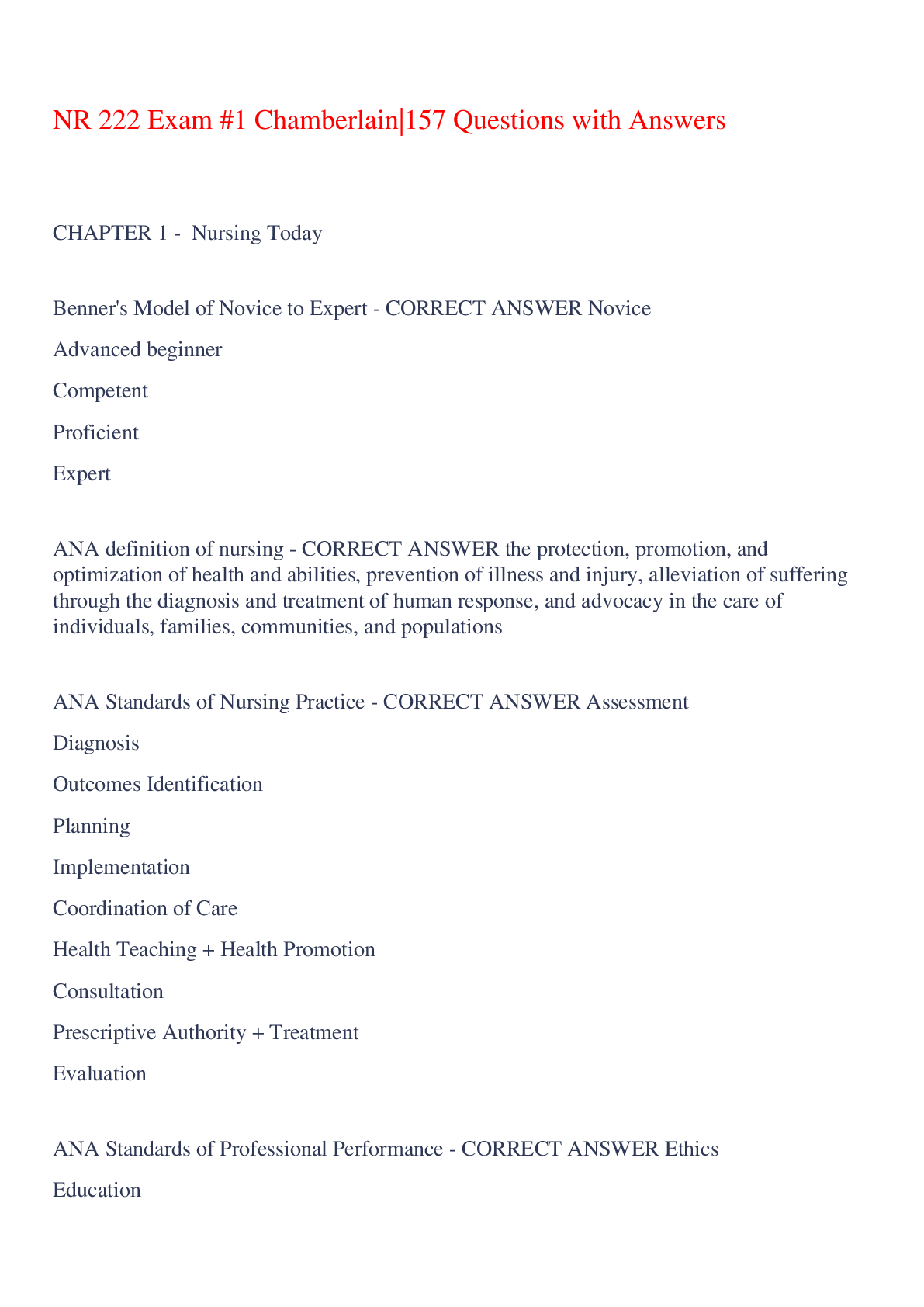
Buy this document to get the full access instantly
Instant Download Access after purchase
Add to cartInstant download
We Accept:

Reviews( 0 )
$14.00
Document information
Connected school, study & course
About the document
Uploaded On
Apr 26, 2023
Number of pages
36
Written in
Additional information
This document has been written for:
Uploaded
Apr 26, 2023
Downloads
0
Views
30













